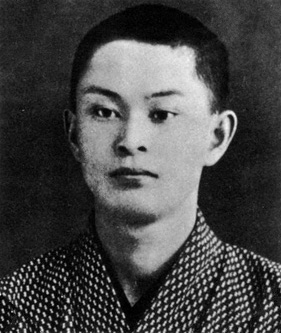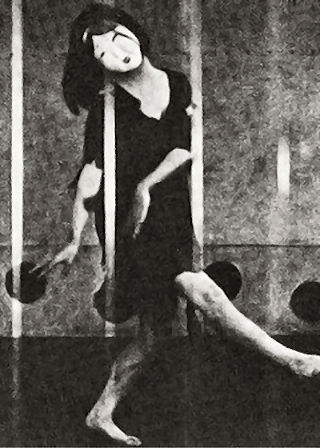|
Shinkankakuha
was a pre-war Japanese literary group led by Riichi Yokomitsu and Yasunari Kawabata which focused on exploring "new impressions" or "new perceptions" in the writing of Japanese literature. Riichi Yokomitsu wrote "The phenomenon of perception for ''Shinkankakuha'' is, to put it briefly, the direct, intuitive sensation of a subjectivity that peels away the naturalized exterior aspects and leaps into the thing itself." History After the 1923 Great Kantō earthquake and the deadly fire it caused, new technologies such as subway, airplane, and radio were transforming Japan. Meanwhile, a new conception of modern life also appeared. ''Shinkankakuha'' developed during this period as the start of Japan's modernist movement, influenced by European modernism. In order to oppose the literary mainstream, Kawabata, Yokomitsu, and other young writers started a new literary journal called in 1924, which was a medium of new movement in modern Japanese literature. Articles in this journal were ma ... [...More Info...] [...Related Items...] OR: [Wikipedia] [Google] [Baidu] |
Yasunari Kawabata
was a Japanese novelist and short story writer whose spare, lyrical, subtly shaded prose works won him the Nobel Prize in Literature in 1968, the first Japanese author to receive the award. His works have enjoyed broad international appeal and are still widely read. Early life Born into a well-established family in Osaka, Japan, Kawabata was orphaned by the time he was four, after which he lived with his grandparents. He had an older sister who was taken in by an aunt, and whom he met only once thereafter, in July 1909, when he was ten. She died when Kawabata was 11. Kawabata's grandmother died in September 1906, when he was seven, and his grandfather in May 1914, when he was fifteen. Having lost all close paternal relatives, Kawabata moved in with his mother's family, the Kurodas. However, in January 1916, he moved into a boarding house near the junior high school (comparable to a modern high school) to which he had formerly commuted by train. After graduating in March 1917 ... [...More Info...] [...Related Items...] OR: [Wikipedia] [Google] [Baidu] |
A Page Of Madness
is a 1926 Japanese silent film directed by Teinosuke Kinugasa. Lost for 45 years until it was rediscovered by Kinugasa in his storehouse in 1971, the film is the product of an avant-garde group of artists in Japan known as the Shinkankakuha (or School of New Perceptions) who tried to overcome naturalistic representation. Yasunari Kawabata, who would win the Nobel Prize for Literature in 1968, was credited on the film with the original story. He is often cited as the screenwriter, and a version of the scenario is printed in his complete works, but the scenario is now considered a collaboration between him, Kinugasa, Banko Sawada, and Minoru Inuzuka. Eiji Tsuburaya is credited as an assistant cameraman. Plot The film takes place in an asylum in the countryside. Amid a torrential rainstorm, a janitor wanders through the halls revealing the various patients with mental illnesses. The next day, a young woman arrives and is surprised to see her father, the janitor, working there. ... [...More Info...] [...Related Items...] OR: [Wikipedia] [Google] [Baidu] |
Horiguchi Daigaku
was a poet and translator of French literature in Taishō and Shōwa period Japan. He is credited with introducing French surrealism to Japanese poetry, and to translating the works of over 66 French authors into Japanese. Early life Horiguchi was born in the Hongō neighborhood of Tokyo. His father, Horiguchi Kumaichi was the son of ex-samurai from Echigo and a career diplomat with the Foreign Ministry who was the Japanese consul at Incheon during the First Sino-Japanese War. Horiguchi attended the Literature Department of Keio University, but never graduated (which is rather ironic, since his given name "Daigaku" is written with the same ''kanji'' as "university", and came from the fact that his father was still a student at Tokyo Imperial University when he was born). Even prior to entering the university, he was a member of the '' Shinshisha'' (The New Poetry Society) and contributing tanka poetry to ''Subaru'' (''Pleiades'') and other literary magazines, such as Mita Bun ... [...More Info...] [...Related Items...] OR: [Wikipedia] [Google] [Baidu] |
Riichi Yokomitsu
was an experimental, modernist Japanese writer. Yokomitsu began publishing in dōjinshi such as ''Machi'' ("Street") and ''Tō'' ("Tower") after entering Waseda University in 1916. In 1923, he published ''Nichirin'' ("The Sun"), ''Hae'' ("A Fly") and more in the magazine ''Bungeishunjū'', which made his name popular. The following year he started the magazine ''Bungei-Jidai'' with Yasunari Kawabata was a Japanese novelist and short story writer whose spare, lyrical, subtly shaded prose works won him the Nobel Prize in Literature in 1968, the first Japanese author to receive the award. His works have enjoyed broad international appeal a ... and others. Yokomitsu and others involved in ''Bungei-Jidai'' were known collectively as the ''Shinkankakuha'', or the New Sensation School, with a particular interest in sensation and scientific objectivity. References External links * Synopsis of ''Shanghai'' (''Shanhai'')at JLPP (Japanese Literature Publishing Proj ... [...More Info...] [...Related Items...] OR: [Wikipedia] [Google] [Baidu] |
Yokomitsu Riichi
was an experimental, modernist Japanese writer. Yokomitsu began publishing in dōjinshi such as ''Machi'' ("Street") and ''Tō'' ("Tower") after entering Waseda University in 1916. In 1923, he published ''Nichirin'' ("The Sun"), ''Hae'' ("A Fly") and more in the magazine ''Bungeishunjū'', which made his name popular. The following year he started the magazine ''Bungei-Jidai'' with Yasunari Kawabata was a Japanese novelist and short story writer whose spare, lyrical, subtly shaded prose works won him the Nobel Prize in Literature in 1968, the first Japanese author to receive the award. His works have enjoyed broad international appeal a ... and others. Yokomitsu and others involved in ''Bungei-Jidai'' were known collectively as the ''Shinkankakuha'', or the New Sensation School, with a particular interest in sensation and scientific objectivity. References External links * Synopsis of ''Shanghai'' (''Shanhai'')at JLPP (Japanese Literature Publishing Proj ... [...More Info...] [...Related Items...] OR: [Wikipedia] [Google] [Baidu] |
1920s In Japan
Nineteen or 19 may refer to: * 19 (number), the natural number following 18 and preceding 20 * one of the years 19 BC, AD 19, 1919, 2019 Films * ''19'' (film), a 2001 Japanese film * ''Nineteen'' (film), a 1987 science fiction film Music * 19 (band), a Japanese pop music duo Albums * ''19'' (Adele album), 2008 * ''19'', a 2003 album by Alsou * ''19'', a 2006 album by Evan Yo * ''19'', a 2018 album by MHD * ''19'', one half of the double album ''63/19'' by Kool A.D. * ''Number Nineteen'', a 1971 album by American jazz pianist Mal Waldron * ''XIX'' (EP), a 2019 EP by 1the9 Songs * "19" (song), a 1985 song by British musician Paul Hardcastle. * "Nineteen", a song by Bad4Good from the 1992 album ''Refugee'' * "Nineteen", a song by Karma to Burn from the 2001 album ''Almost Heathen''. * "Nineteen" (song), a 2007 song by American singer Billy Ray Cyrus. * "Nineteen", a song by Tegan and Sara from the 2007 album '' The Con''. * "XIX" (song), a 2014 song by Slipknot. ... [...More Info...] [...Related Items...] OR: [Wikipedia] [Google] [Baidu] |
Paul Morand
Paul Morand (13 March 1888 – 24 July 1976) was a French author whose short stories and novellas were lauded for their style, wit and descriptive power. His most productive literary period was the interwar period of the 1920s and 1930s. He was much admired by the upper echelons of society and the artistic avant-garde who made him a cult favorite. He has been categorized as an early Modernist and Imagist. Morand was a graduate of the Paris Institute of Political Studies, preparing him for a diplomatic career, and also attended Oxford University. A member of the upper class and married into wealth, he held various diplomatic posts and traveled widely. He was typical of those in his social group who enjoyed lives of privilege and entitlement, adhering to the inevitability and desirability of class distinction. Morand espoused a reflexive adherence to racial, ethnic and anti-Semitic ideologies. His intellectual influences included the writing of Friedrich Nietzsche, Oswald Spengler ... [...More Info...] [...Related Items...] OR: [Wikipedia] [Google] [Baidu] |
Kyūjitai
''Kyūjitai'' ( ja, 舊字體 / 旧字体, lit=old character forms) are the traditional forms of kanji, Chinese written characters used in Japanese. Their simplified counterparts are ''shinjitai'' ( ja, 新字体, lit=new character forms, label=none). Some of the simplified characters arose centuries ago and were in everyday use in both China and Japan, but they were considered inelegant, even uncouth. After World War II, simplified character forms were made official in both these countries. However, in Japan fewer and less drastic simplifications were made: for example, "electric" is still written as "" in Japan, as it is also written in Hong Kong, Macau, South Korea and Taiwan, which continue to use traditional Chinese characters, but has been simplified to in mainland China. Prior to the promulgation of the ''tōyō'' kanji list in 1946, ''kyūjitai'' were known as ''seiji'' ( ja, 正字, lit=proper/correct characters, label=none) or ''seijitai'' (). Even after ''kyūjit ... [...More Info...] [...Related Items...] OR: [Wikipedia] [Google] [Baidu] |
World War II
World War II or the Second World War, often abbreviated as WWII or WW2, was a world war that lasted from 1939 to 1945. It involved the vast majority of the world's countries—including all of the great powers—forming two opposing military alliances: the Allies and the Axis powers. World War II was a total war that directly involved more than 100 million personnel from more than 30 countries. The major participants in the war threw their entire economic, industrial, and scientific capabilities behind the war effort, blurring the distinction between civilian and military resources. Aircraft played a major role in the conflict, enabling the strategic bombing of population centres and deploying the only two nuclear weapons ever used in war. World War II was by far the deadliest conflict in human history; it resulted in 70 to 85 million fatalities, mostly among civilians. Tens of millions died due to genocides (including the Holocaust), starvation, ma ... [...More Info...] [...Related Items...] OR: [Wikipedia] [Google] [Baidu] |


